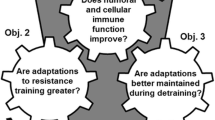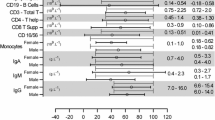Abstract
Comparison of immune function in athletes and nonathletes reveals that the adaptive immune system is largely unaffected by athletic endeavour. The innate immune system appears to respond differentially to the chronic stress of intensive exercise, with natural killer cell activity tending to be enhanced while neutrophil function is suppressed. However, even when significant changes in the level and functional activity of immune parameters have been observed in athletes, investigators have had little success in linking these to a higher incidence of infection and illness.
Many components of the immune system exhibit change after prolonged heavy exertion. During this ‘open window’ of altered immunity (which may last between 3 and 72 hours, depending on the parameter measured), viruses and bacteria may gain a foothold, increasing the risk of subclinical and clinical infection. However, no serious attempt has been made by investigators to demonstrate that athletes showing the most extreme post-exercise immunosuppression are those that contract an infection during the ensuing 1 to 2 weeks. This link must be established before the ‘open window’ theory can be wholly accepted.
The influence of nutritional supplements, primarily zinc, vitamin C, glutamine and carbohydrate, on the acute immune response to prolonged exercise has been measured in endurance athletes. Vitamin C and glutamine have received much attention, but the data thus far are inconclusive. The most impressive results have been reported in the carbohydrate supplementation studies. Carbohydrate beverage ingestion has been associated with higher plasma glucose levels, an attenuated cortisol and growth hormone response, fewer perturbations in blood immune cell counts, lower granulocyte and monocyte phagocytosis and oxidative burst activity, and a diminished pro- and anti-inflammatory cytokine response. It remains to be shown whether carbohydrate supplementation diminishes the frequency of infections in the recovery period after strenuous exercise.
Studies on the influence of moderate exercise training on host protection and immune function have shown that near-daily brisk walking compared with inactivity reduced the number of sickness days by half over a 12- to 15-week period without change in resting immune function. Positive effects on immunosurveillance and host protection that come with moderate exercise training are probably related to a summation effect from acute positive changes that occur during each exercise bout. No convincing data exist that moderate exercise training is linked with improved T helper cell counts in patients with HIV, or enhanced immunity in elderly participants.
Similar content being viewed by others
References
Boros RL, Koch A, Nieman DC. Compendium of the exercise immunology literature, 1995–1997. Paderborn, Germany: International Society of Exercise and Immunology, 1997
Nieman DC, Johanssen LM, Lee JW, et al. Infectious episodes in runners before and after the Los Angeles Marathon. J Sports Med Phys Fit 1990; 30: 316–28
Peters-Futre EM. Vitamin C, neutrophil function, and upper respiratory tract infection risk in distance runners: the missing link. Exerc Immunol Rev 1997; 3: 32–52
Nieman DC. Exercise, upper respiratory tract infection, and the immune system. Med Sci Sports Exerc 1994; 26: 128–39
Pedersen BK, Bruunsgaard H. How physical exercise influences the establishment of infections. Sports Med 1995; 19: 393–400
Shephard RJ, Kavanagh T, Mertens DJ, et al. Personal health benefits of masters athletics competition. Br J Sports Med 1995; 29: 35–40
Baj Z, Kantorski J, Majewska E, et al. Immunological status of competitive cyclists before and after the training season. Int J Sports Med 1994; 15: 319–24
Nieman DC, Buckley KS, Henson DA, et al. Immune function in marathon runners versus sedentary controls. Med Sci Sports Exerc 1995; 27: 986–92
Tvede N, Steensberg J, Baslund B, et al. Cellular immunity in highly-trained elite racing cyclists and controls during periods of training with high and low intensity. Scand J Sports Med 1991; 1: 163–6
Hack V, Strobel G, Weiss M, et al. PMN cell counts and phagocytic activity of highly trained athletes depend on training period. J Appl Physiol 1994; 77: 1731–5
Nieman DC, Henson DA, Gusewitch G, et al. Physical activity and immune function in elderly women. Med Sci Sports Exerc 1993; 25: 823–31
Pedersen BK, Tvede N, Christensen LD, et al. Natural killer cell activity in peripheral blood of highly trained and untrained persons. Int J Sports Med 1989; 10: 129–31
Pyne DB, Baker MS, Fricker PA, et al. Effects of an intensive 12-wk training program by elite swimmers on neutrophil oxidative activity. Med Sci Sports Exerc 1995; 27: 536–42
Pedersen BK, Rohde T, Zacho M. Immunity in athletes. J Sports Med Phys Fitness 1996; 36: 236–45
Mackinnon LT. Immunity in athletes. Int J Sports Med 1997; 18 Suppl. 1: S62–8
Mackinnon LT, Hooper SL, Jones S, et al. Hormonal, immunological, and hematological responses to intensified training in elite swimmers. Med Sci Sports Exerc 1997; 29: 1637–45
Mackinnon LT, Ginn EM, Seymour GJ. Temporal relationship between decreased salivary IgA and upper respiratory tract infection in elite athletes. Aust J Sci Med Sport 1993; 25: 94–9
Gleeson M, Mc Donald WA, Pyne DB, et al. Salivary IgA levels and infection risk in elite swimmers. Med Sci Sports Exerc. In press
Nieman DC. Immune response to heavy exertion. J Appl Physiol 1997; 82: 1385–94
Nieman DC. Exercise immunology: practical applications. Int J Sports Med 1997; 18 Suppl. 1: S91–100
Hoffman-Goetz L, Pedersen BK. Exercise and the immune system: a model of the stress response? Immunol Today 1994; 15: 382–7
Pedersen BK, Ostrowski K, Rhode T, et al. Strenuous exercise – a model of the cytokine response to trauma and sepsis. Can J Physiol Pharmacol 1998; 76: 505–11
Nieman DC. Influence of carbohydrate on the immune response to intensive, prolonged exercise. Exerc Immunol Rev 1998; 4: 64–76
Pedersen BK, Bruunsgaard H, Klokker M, et al. Exerciseinduced immunomodulation – possible roles or neuroendocrine and metabolic factors. Int J Sports Med 1997; 18 Suppl. 1: S2–7
Bruunsgaard H, Galbo H, Halkjaer-Kristensen J, et al. Exerciseinduced increase in serum interleukin-6 in humans is related to muscle damage. J Physiol (Lond) 1997; 499 (Pt 3): 833–41
Rohde T, MacLean DA, Richter EA, et al. Prolonged submaximal eccentric exercise is associated with increased levels of plasma IL-6. Am J Physiol 1997; 273 (1 Pt 1): E85–91
Ostrowski K, Rohde T, Zacho M, et al. Evidence that IL-6 is produced in skeletal muscle during intense long-term muscular activity. J Physiol (Lond) 1998; 508 (Pt 3): 949–53
Bruunsgaard H, Hartkopp A, Mohr T, et al. In vivo cell-mediated immunity and vaccination response following prolonged, intense exercise. Med Sci Sports Exerc 1997; 29: 1176–81
Gleeson M, Pyne DB, McDonald WA, et al. Pneumococcal antibody responses in elite swimmers. Clin Exp Immunol 1996; 105: 238–44
Eskola J, Ruuskanen O, Soppi E, et al. Effect of sport stress on lymphocyte transformation and antibody formation. Clin Exp Immunol 1978; 32: 339–45
Nieman DC, Henson DA, Butterworth DE, et al. Vitamin C supplementation does not alter the immune response to 2.5 hours of running. Int J Sports Nutr 1997; 7: 174–84
Castell LM, Poortmans JR, Leclercq R, et al. Some aspects of the acute phase response after a marathon race, and the effects of glutamine supplementation. Eur J Appl Physiol 1997; 75: 47–53
Castell LM, Poortmans JR, Newsholme EA. Does glutamine have a role in reducing infections in athletes? Eur J Appl Physiol 1996; 73: 488–51
Mackinnon LT, Hooper SL. Plasma glutamine and upper respiratory tract infection during intensified training in swimmers. Med Sci Sports Exerc 1996; 28: 285–90
Rohde T, MacLean DA, Hartkopp A, et al. The immune system and serum glutamine during a triathlon. Eur J Appl Physiol 1996; 74: 428–34
Shewchuk LD, Baracos VE, Field CJ. Dietary L-glutamine does not improve lymphocyte metabolism or function in exercisetrained rats. Med Sci Sports Exerc 1997; 29: 474–81
Rowbottom DG, Keast D, Morton AR. The emerging role of glutamine as an indicator of exercise stress and overtraining. Sports Med 1996; 21: 80–97
Peters EM, Goetzsche JM, Joseph LE, et al. Vitamin C as effective as combinations of anti-oxidant nutrients in reducing symptoms of upper respiratory tract infection in ultramarathon runners. S Afr J Sports Med 1996; 11 (3): 23–7
Peters EM, Goetzsche JM, Grobbelaar B, et al. Vitamin C supplementation reduces the incidence of postrace symptoms of upper-respiratory-tract infection in ultramarathon runners. Am J Clin Nutr 1993; 57: 170–4
Peters EM. Exercise and upper respiratory tract infections: a review. S Afr J Sports Med 1996; 11: 9–14
Nehlsen-Cannarella SL, Fagoaga OR, Nieman DE, et al. Carbohydrate and the cytokine response to 2.5 hours of running. J Appl Physiol 1997; 82: 1662–7
Nieman DC, Fagoaga OR, Butterworth DE, et al. Carbohydrate supplementation affects blood granulocyte and monocyte trafficking but not function after 2.5 h of running. Am J Clin Nutr 1997; 66: 153–9
Nieman DC, Henson DA, Garner EB, et al. Carbohydrate affects natural killer cell redistribution but not activity after running. Med Sci Sports Exerc 1997; 29: 1318–24
Nieman DC, Nehlsen-Cannarella SL, Fagoaga OR, et al. Influence of mode and carbohydrate on the cytokine response to heavy exertion. Med Sci Sports Exerc 1998; 30: 671–8
Nieman DC, Nehlsen-Cannarella SL, Fagoaga OR, et al. Influence of mode and carbohydrate on the granulocyte and monocyte response to intensive, prolonged exercise. J Appl Physiol 1998; 84: 1252–9
Henson DA, Nieman DC, Blodgett AD, et al. Influence of mode and carbohydrate on the immune response to long endurance exercise. Int J Sports Nutr. In press
Nieman DC, Nehlsen-Cannarella SL, Markoff, PA, et al. The effects of moderate exercise training on natural killer cells and acute upper respiratory tract infections. Int J Sports Med 1990; 11: 467–73
Nieman DC, Nehlsen-Cannarella SL, Henson DA, et al. Immune response to exercise training and/or energy restriction in obese women. Med Sci Sports Exerc 1998; 30: 679–86
Ullum H, Palmø J, Halkjær-Kristensen J, et al. The effect of acute exercise on lymphocyte subsets, natural killer cells, proliferative response and cytokines in HIV seropositive persons. J AIDS 1994; 7: 1122–32
Pedersen BK. Exercise and HIV infection. In: Rippe J, editor. Textbook of medicine, exercise, nutrition and health. London: Blackwell Science, Inc. In press
Laperriere AR, Fletcher MA, Antoni MH, et al. Aerobic exercise training in an AIDS risk group. Int J Sports Med 1991; 12 Suppl. 1: S53–7
Rigsby LW, Dishman RK, Jackson AW, et al. Effects of exercise training on men seropositive for the human immunodeficiency virus-1. Med Sci Sports Exerc 1992; 24: 6–12
Calabrese LH, LaPerriere A. Human immunodeficiency virus infection, exercise and athletics. Sports Med 1993; 15: 6–13
Shinkai S, Kohno H, Kimura K, et al. Physical activity and immune senescence in men. Med Sci Sports Exerc 1995; 27: 1516–26
Rall LC, Roubenoff R, Cannon JG, et al. Effects of progressive resistance training on immune response in aging and chronic inflammation. Med Sci Sports Exerc 1996; 28: 1356–65
Author information
Authors and Affiliations
Corresponding author
Rights and permissions
About this article
Cite this article
Nieman, D.C., Pedersen, B.K. Exercise and Immune Function. Sports Med 27, 73–80 (1999). https://doi.org/10.2165/00007256-199927020-00001
Published:
Issue Date:
DOI: https://doi.org/10.2165/00007256-199927020-00001




